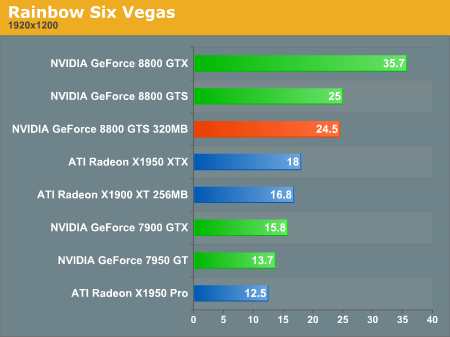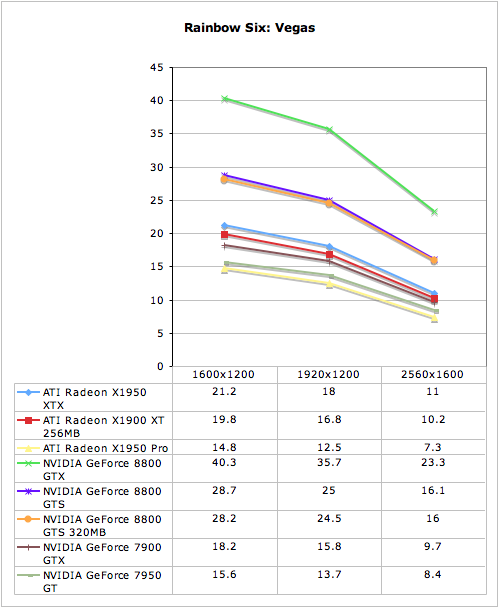Power Within Reach: NVIDIA's GeForce 8800 GTS 320MB
by Derek Wilson on February 12, 2007 9:00 AM EST- Posted in
- GPUs
Rainbow Six: Vegas Performance
Using the Unreal Engine 3, Rainbow Six: Vegas is a graphically stunning game. Unfortunately, the console has been disabled in Vegas, and we are unable to use any timedemo functionality that may exist in Epic's latest engine. Thus, we are forced to use FRAPS. The opening scene is the subject of our benchmark: a helicopter ride over a city. The camera is positioned to get a good mix of looking out the window and the two passengers sitting across from the player. This benchmark is very consistent with itself, but gameplay tends to be even more stressful on the hardware. Cards that run at 30 frames per second in our benchmark often drop to 20 in a fire fight. This is important to keep in mind. We are using version 1.04 of the game and all the options are turned on and up as high as possible with the exception of vsync which is disabled.


We are unable to test AA with this game, but with such low framerates running on most hardware, AA would probably hurt as much as it helped. Rainbow Six: Vegas, much like Oblivion, is a great looking game that requires a whole lot of power to run with all the settings turned up. And, also like Oblivion, Rainbow Six: Vegas performance is unaffected by the amount of memory on an 8800 GTS.
Using the Unreal Engine 3, Rainbow Six: Vegas is a graphically stunning game. Unfortunately, the console has been disabled in Vegas, and we are unable to use any timedemo functionality that may exist in Epic's latest engine. Thus, we are forced to use FRAPS. The opening scene is the subject of our benchmark: a helicopter ride over a city. The camera is positioned to get a good mix of looking out the window and the two passengers sitting across from the player. This benchmark is very consistent with itself, but gameplay tends to be even more stressful on the hardware. Cards that run at 30 frames per second in our benchmark often drop to 20 in a fire fight. This is important to keep in mind. We are using version 1.04 of the game and all the options are turned on and up as high as possible with the exception of vsync which is disabled.


We are unable to test AA with this game, but with such low framerates running on most hardware, AA would probably hurt as much as it helped. Rainbow Six: Vegas, much like Oblivion, is a great looking game that requires a whole lot of power to run with all the settings turned up. And, also like Oblivion, Rainbow Six: Vegas performance is unaffected by the amount of memory on an 8800 GTS.










55 Comments
View All Comments
nicolasb - Monday, February 12, 2007 - link
The conclusion to this article:This conclusion does not seem to bear much resemblance to the actual observations. In virtually every case the card performed well without AA, but dismally as soon as 4xAA was switched on. A fair conclusion would be to recommend the card for resolutions up to 1920x1200 without AA, but definitely not with.
DerekWilson - Monday, February 12, 2007 - link
The GTS 320MB still performs well if taken on its own at 19x12 with 4xAA ... But I will modify the comment to better reflect what I mean.nicolasb - Tuesday, February 13, 2007 - link
The way the conclusion now reads is a big improvement, IMNSHO. :-)munky - Monday, February 12, 2007 - link
I was expecting better performance with AA enabled, and the article just glossed over the fact that the in half the games with AA the card performed on par or worse than last gen card that cost less.Bob Markinson - Monday, February 12, 2007 - link
For the base Oblivion install, yes, it's not so much of a memory hog. In-game texture use usually doesn't exceed 256 MB with HDR and 4xAA on @ 1152x864. (Also, please test AA perf too with HDR, both ATI and Nvidia do support it on their current gen cards at the same time.)Most popular texture mods will bring up the memory usage north of 500 MB. I've seen it hit over 700 MB. Thus, there's a good chance that any 256 MB card would be crippled with texture swapping. I should know, mine is.
Bob Markinson - Monday, February 12, 2007 - link
For the base Oblivion install, yes, it's not so much of a memory hog. In-game texture use usually doesn't exceed 256 MB with HDR and 4xAA on @ 1152x864. (Also, please test AA perf too with HDR, both ATI and Nvidia do support it on their current gen cards at the same time.)Most popular texture mods will bring up the memory usage north of 500 MB. I've seen it hit over 700 MB. Thus, there's a good chance that any 256 MB card would be crippled with texture swapping. I should know, mine is.
DerekWilson - Monday, February 12, 2007 - link
What texture mod would you recommend we test with?Bob Markinson - Monday, February 12, 2007 - link
Qarl's Texture Pack 2 and 3 are quite popular world texture packs. Please check this site for more details:http://devnull.devakm.googlepages.com/totoworld">http://devnull.devakm.googlepages.com/totoworld
Note that version 3 really does need a lot of texture memory. Also, check out Qarl's 4096 compressed landscape LOD normal map texture pack, it'll add far more depth than the plain, overly filtered Oblivion LOD textures.
DerekWilson - Monday, February 12, 2007 - link
We will take a look at those texture packs and do some testing ...Hopefully we can provide a follow up further exploring the impact of memory on the 8800 architecture.
blackbrrd - Monday, February 12, 2007 - link
I looked at the Oblivion scores, and the first thing that hit me was: they are using the standard crappy looking textures!No oblivion fan running a 8800gts would run with the standard texture pack. It is, at times, really really bad.
Running a texture pack like the one above is quite normal. If you have enough video card memory there isn't much of a slowdown - except when the data is loaded into memory - which happends all the time... It does make the game look nicer though!